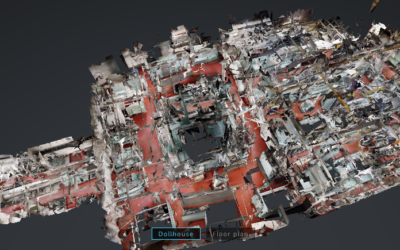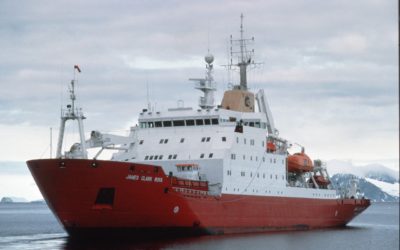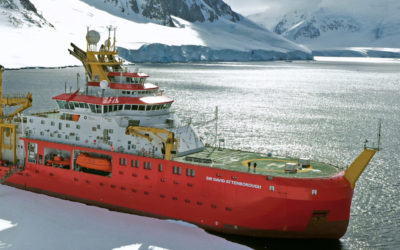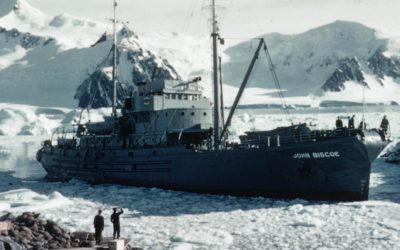Multibeam echosounder
shipborne science
RRS James Clark Ross (JCR), launched by HM the Queen in 1990, is primarily a marine research vessel for biological, oceanographic and geophysical cruises. It is equipped with a suite of laboratories and winch systems that allows scientific equipment to be deployed astern or amidships. The ship has an extremely low noise signature, allowing the deployment of sensitive acoustic equipment. A swath bathymetry system was fitted in 2000. The JCR also carries out some cargo and logistical work. During the northern summer the JCR supports NERC research, largely in the Arctic.
RRS James Clark Ross (named after Admiral Sir James Clark Ross, R.N.) was built by Swan Hunter Shipbuilders, Wallsend, UK. The vessel can steam at a steady two knots through level sea ice one metre thick. To assist passage through heavy pack ice a compressed air system rolls the ship from side to side freeing the passage.
Researchers describe how they use robotic technologies to measure ice shelves and sea ice.

RRS James Clark Ross contains some of Britain’s most advanced facilities for oceanographic research.
The ship is equipped for geophysical studies, with a compressor bank to power a seismic air gun array, and large aft and starboard decks for scientific equipment deployed by aft and midships gantries.
For biological studies, the vessel can deploy a wide range of sampling gear and benefits from modern underway instrumentation.
The ship is designed with an extremely low noise signature to allow sensitive underwater acoustic equipment to operate effectively.
Some scientific equipment may be installed on board for the duration of a particular scientific cruise and removed at the end. This equipment is not listed here.
Sperry Marine Integrated Bridge System, incorporating:
Local Area Network system with back-up is installed for cruise instrumentation and equipment. Instrumentation continuously logged on the central computing systems. Facilities are available for data transmission via satellite to and from the ship.
Facilities and services for four containers on aft deck and one container on the fwd deck.
shipborne science
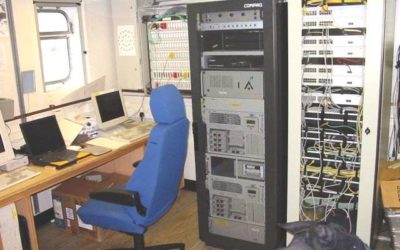
Hardware for general use 4 x public use PC workstations with minimum i5 processor, 8GB RAM and 19″ screen Principle Scientist cabin: i5 PC with 24″ screen Local area network …
The RRS James Clark Ross has a purpose build scientific mooring winch, which is capable of deploying mooring of up to 4000m length of 14mm rope diameter. The winch has a …
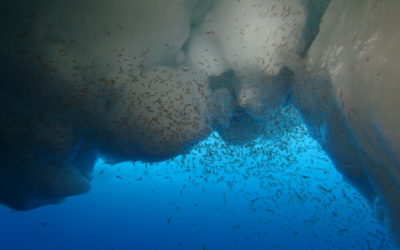
Shallow UW Camera System can work to depth up to 1000m, showing a black and white live low resolution video stream and can take colour high resolution stills. The system consists …
15 October, 2020 by Sharon Grant
To celebrate Black History Month Sharon Grant describes her time working for British Antarctic Suirvey in this guest blog.
15 February, 2019 by Nadescha Zwerschke
Nadescha Zwerschke is a marine biologist, who was travelling on the RRS James Clark Ross (JCR) as part of the ICEBERGS 2 cruise in December 2018. Having left Burdwood Bank …
9 March, 2018 by Carwyn Davies
Mechanical engineer Carwyn Davies, from British Antarctic Survey’s Antarctic Marine Engineering (AME) is working onboard the RRS James Clark Ross with our science team to investigate Larsen C Benthos. Find …
28 February, 2018 by Mel Mackenzie
Dr Mel Mackenzie, a Collection Manager of Marine Invertebrates at Museums Victoria in Melbourne, is living and working on board the BAS research ship RRS James Clark Ross for the …
22 February, 2018 by Rowan Whittle
British Antarctic Survey (BAS) palaeobiologist Dr Rowan Whittle is a member of the Larsen C Benthos research cruise onboard the RRS James Clark Ross. Rowan’s primary role is to assist …
28 December, 2017 by Ryan Scott
Following the glider deployments our next destination was Rothera, the UK’s biggest Antarctic research station on Adelaide Island. Good progress was made until we hit the sea ice – 120 …
12 December, 2017 by Ryan Scott
First thing I learn as I begin my trip aboard the RRS James Clark Ross is that, scientist on research cruises need to be able to adapt quickly! Within two …
29 November, 2017 by Ryan Scott
After 6 days, 9505 miles and 7 mm of beard growth, the cruise has officially started! Thursday 16th November and finally the time had come for me start my journey …
25 January, 2017 by Geraint Tarling
By Dr Geraint Tarling Lanternfish are found in many of the world’s oceans and get their name from the numerous photophores (light organs) that occur all over their bodies. Also …
24 November, 2016 by Yvonne Firing
Follow ORCHESTRA project scientist Yvonne Firing’s amazing fieldwork blog from the Southern Ocean here. On the 2016/2017 Drake Passage cruise on the RRS James Clark Ross, we sail south from …
16 November, 2016 by Helen Jones
New blog from ship’s doctor Helen Jones as RRS James Clark Ross arrives at Signy research station in the South Orkney Islands Well, and what a wonderful couple of days …
10 April, 2016 by Dani Jones
Investigating the Southern Ocean Oceanographers Dan Jones and Erik MacKie are onboard the RRS James Clark Ross carrying out a hydrographic survey in the Southern Ocean as part of a …
31 March, 2016 by Susie Grant
The ship’s science labs have all been packed up and cleaned, kit boxes stowed in the container, cargo paperwork finished and cruise reports written. The SO-AntEco team is ready to …
25 March, 2016 by Hilary Blagbrough
Oh look it’s snowing/raining and getting dark… it must be time for the Night Shift. I’m Hilary, the night shift leader on the SO-AntEco scientific cruise to the South Orkney …
23 March, 2016 by Susie Grant
Last week was UK Science Week, and we asked schools and anyone else who had burning questions about the Antarctic deep sea to send them to us here on the …
16 March, 2016 by Laura Robinson
Lost in a Sea of Biology! Dr Laura Robinson is interested in documenting and understanding the processes that govern climate on time scales ranging from the modern day back through hundreds of …
5 March, 2016 by Oliver Ashford
New ‘buoy’ at sea Oliver Ashford – a PhD student from Oxford University – is the youngest member of the SO-AntEco research cruise onboard the RRS James Clark Ross. He’s working with …
15 February, 2016 by Huw Griffiths
As the days count down towards departure the dreams about forgetting my passport at the airport become more frequent. My office in Cambridge is a long way from the Antarctic …
12 February, 2016 by Alex Taylor
Despite being one of BAS’s smallest stations, I would argue that Signy is one of the most remote. Situated in the South Orkney Islands, at a relatively northerly 60 degrees …
21 October, 2015 by Sian Henley
Find out about NERC Research Fellow Dr Sian Henley’s preparations for her fifth visit to Rothera Research Station and what she looks forward to onboard the RRS James Clark Ross.
19 August, 2021
After 30 years of service with British Antarctic Survey the RRS James Clark Ross has been sold to the Ukrainian National Antarctic Scientific Centre. This is the second time that …
29 March, 2021
The RRS James Clark Ross arrived in Harwich yesterday, completing its final season with British Antarctic Survey. After 30 years of service, the ship will soon be sold. The ship …
1 March, 2021
Today (Monday 1 March 2021) the RRS James Clark Ross (JCR) makes her final call to her home port of the Falkland Islands. After 30 years of service, the JCR will be sold at the end of her 20/21 Antarctic season. …
23 February, 2021
On Friday 19 February 2021 the RRS James Clark Ross made her final call to Rothera Research Station. After 30 years of service, the JCR will be sold at the end of the …
8 January, 2021
The BAS field season is underway. Since the RRS James Clark Ross departed the UK in November last year, it has safely delivered summer and wintering staff and essential cargo …
18 December, 2020
Staff at British Antarctic Survey (BAS) ships and research stations prepare to celebrate the festive season. It’s been a year like no other, with extraordinary arrangements made to keep facilities …
15 December, 2020
UPDATE 15/12/2020: Opening Signy Research Station RRS James Clark Ross arrived at Signy Island on 15 December. Signy Island is one of the remote South Orkney Islands, which lie more …
13 November, 2020
The UK Prime Minister has announced today (Friday 13 November) a new Marine Protected Zone around the overseas territory of the island of Tristan da Cunha. The move is part …
7 April, 2020
Exceptional plans to repatriate our people at the end of the Antarctic summer field season
31 January, 2020
Large brown seaweed can bring invasive species to Antarctica, according to research published today (31 January 2020) in the journal Scientific Reports. The new study describes the first scientific evidence …
18 June, 2019
The debut mission involving the autonomous submarine Autosub Long Range – affectionately known as Boaty McBoatface – has for the first time shed light on a key process linking increasing …
22 March, 2019
A team of researchers led by British Antarctic Survey has for the first time mapped the deepest part of the South Sandwich Trench in the Southern Ocean. This part of …
26 April, 2018
A team of scientists on board the RRS James Clark Ross (JCR) has conducted marine biodiversity research around the Island of St Helena with a team of UK based and …
16 March, 2018
The RRS James Clark Ross left the Falkland Islands yesterday (15th March) and is travelling towards Tristan Da Cunha, with expected arrival on the 22nd March. The vessel will survey …
12 February, 2018
A team of scientists, led by British Antarctic Survey (BAS), heads to Antarctica this week (14 February) to investigate a mysterious marine ecosystem that’s been hidden beneath an Antarctic ice …
26 June, 2017
One of the best-known impacts of climate change is the loss of sea ice in the Arctic, but also in parts of the Antarctic: the poles are increasingly turning from …
7 April, 2017
The unmanned submersible Boaty McBoatface was deployed in the Antarctic for the first time.
17 March, 2017
A new study reveals the sub-antarctic island of South Georgia – famous for its wildlife – was covered by a massive ice cap during the last ice age. The results …
13 March, 2017
Boaty McBoatface is joining ocean scientists from the University of Southampton and British Antarctic Survey (BAS) on an expedition to study some of the deepest and coldest abyssal ocean waters …
30 January, 2017
An international team of researchers has discovered why fresh water, melted from Antarctic ice sheets, is often detected below the surface of the ocean, rather than rising to the top …
29 November, 2016
As spring returns to the southern hemisphere British Antarctic Survey (BAS) has started another research season which will take them over land, sea and ice in search of answers to …
26 September, 2016
On 20 September 2016 the British Antarctic Survey ship, the RRS James Clark Ross, set sail on its long voyage from Immingham in the UK to Stanley in the Falkland …
20 September, 2016
Scientists have discovered that Antarctic krill – a tiny shrimp-like crustacean – plays a key role in fertilising the Southern Ocean with iron, which stimulates the growth of phytoplankton, the …
1 September, 2016
A new marine biodiversity study in one of the largest Marine Protected Areas in the world reveals the impact of environmental change on subantarctic seabed animals and answers big questions …
14 July, 2016
A new study has found for the first time that ocean warming is the primary cause of retreat of glaciers on the Antarctic Peninsula. The Peninsula is one of the largest current contributors to sea-level rise and this new finding will enable researchers to make better predictions of ice loss from this region.
23 November, 2015
The contract for the UK’s new polar research ship was signed NERC’s Chief Operating Office Paul Fox and Cammell Laird Chief Executive, John Syvret CBE on Friday 19 November 2015 …
12 October, 2015
Government announces preferred bidder to build new polar ship Minister of State for Universities and Science, Jo Johnson announced today that the preferred bidder to build a new polar research …
9 September, 2015
Researchers from the Arctic Research Programme, managed at British Antarctic Survey (BAS), have shown for the first time that phytoplankton (plant life) in remote ocean regions can contribute to rare …
19 December, 2014
British Antarctic Survey staff prepare to celebrate Christmas far away from home As you make the last preparations for the festive period, spare a thought for those who will be …
25 November, 2014
Stamp of approval for iSTAR The iSTAR programme, which is looking at the stability of Pine Island Glacier in Antarctica, is featured in a new set of British Antarctic Territory …
24 November, 2014
Underwater robot sheds new light on Antarctic sea ice The first detailed, high-resolution 3-D maps of Antarctic sea ice have been developed using an underwater robot. Scientists from the UK, …
10 February, 2014
First leg of Antarctic iSTAR mission accomplished A team of British scientists has returned from a gruelling 1500km journey across the ice of West Antarctica after successfully completing the first …
14 January, 2014
Focus on Pine Island Glacier, Antarctica Pine Island Glacier, on the West Antarctic Ice Sheet (WAIS) is the largest single contributor to sea-level rise in Antarctica. The stability of the …
24 December, 2013
Christmas messages from Antarctic staff Many British Antarctic Survey scientists and support staff will be spending this Christmas thousands of miles from home on the frozen continent. BAS has five …
20 December, 2013
British Antarctic Survey field season is underway On the eve of the centenary year of Ernest Shackleton’s Endurance Expedition the ship which bears his name is playing a crucial role …
3 December, 2013
New species recovered from Amundsen Sea More than thirty new, and, as yet unclassified, species of marine life were discovered during a science expedition to the Amundsen Sea off Pine …
18 November, 2013
Series of large earthquakes in Scotia Sea close to South Orkney Islands A series of earthquakes has been detected in the Scotia Sea region close to the British Antarctic Survey’s …
17 October, 2013
New UK report shows that respect for Arctic states, local people and the environment is fundamental to Arctic engagement Today, for the first time, the UK Government has set out …
25 November, 2012
First evidence of ocean acidification affecting live marine creatures in the Southern Ocean The shells of marine snails – known as pteropods – living in the seas around Antarctica are …
3 August, 2012
An international team of scientists from the US, Norway, Germany and Holland are currently on the British Antarctic Survey’s RRS James Clark Ross trying to understand more about the behaviour …
2 February, 2012
One of the most comprehensive studies of animals in the Southern Ocean reveals a region that is under threat from the effects of environmental change. Reporting in January 2012 in …
4 January, 2012
Communities of species previously unknown to science have been discovered on the seafloor near Antarctica, clustered in the hot, dark environment surrounding hydrothermal vents. The discoveries, made by teams led …
21 November, 2011
On the eve of the centenary of Sir Robert Falcon Scott’s expedition to the Antarctic, the British Antarctic Survey (BAS) 20011/12 field season is underway. The start of the season …
4 August, 2011
Staff at British Antarctic Survey’s Rothera Research Station recently raised the Union flag to mark the first sighting of the sun again after several weeks of continual darkness. The sun …
11 July, 2011
Underwater Antarctic volcanoes discovered in the Southern Ocean Scientists from British Antarctic Survey (BAS) have discovered previously unknown volcanoes in the ocean waters around the remote South Sandwich Islands. Using …
4 July, 2011
Antarctic krill help to fertilise Southern Ocean with iron A new discovery reveals that the shrimp-like creature at the heart of the Antarctic food chain could play a key role …
27 June, 2011
Warm ocean speeds melting of Antarctic glacier New results from an investigation into a large glacier in Antarctica and its impact on global sea level rise are published this week …
13 June, 2011
New discovery – Copepods share “diver’s weight belt” technique with whales A deep-sea mystery has been solved with the discovery that the tiny 3 mm long marine animals, eaten by …
20 June, 2010
New research sheds light on Antarctica”s melting Pine Island Glacier New results from an investigation into Antarctica’s potential contribution to sea level rise are reported this week (Sunday 20 June) …
8 February, 2010
As the Antarctic field season continues with the usual mix of exciting research programmes new enhancements to the online satellite image system that improves ship safety and efficiency are launched. …
17 December, 2009
New photographs of ice fish, octopus, sea pigs, giant sea spiders, rare rays and beautiful basket stars that live in Antarctica’s continental shelf seas are revealed this week by the …
28 August, 2009
Heavy-duty vehicles set to be shipped to the Antarctic went on show in Cambridge this week. British Antarctic Survey showcased its unique fleet of vehicles at its offices in Cambridge. …
5 May, 2009
New Antarctic seabed sonar images reveal clues to sea-level rise Motorway-sized troughs and channels carved into Antarctica’s continental shelves by glaciers thousands of years ago could help scientists to predict …
17 March, 2009
Robot submarine searches for signs of melting under Antarctic Ice Shelf A team of British and American scientists has successfully deployed an autonomous robot submarine on six missions beneath an …
9 January, 2009
British Antarctic Survey (BAS) scientists and colleagues from the National Oceanography Centre, Southampton (NOCS), the Zoological Society of London and Woods Hole Oceanographic Institution in the USA are set to …
27 September, 2005
Antarctic is a beautiful new DVD/Book that describes through music, sound, film, photography and literature, composer Craig Vear’s three month journey into the mysterious frozen world of Antarctica. Craig Vear …
The ASCCC Project has been funded by ACE (Antarctic Circumnavigation Expedition) to investigate, quantify and understand the role of polar and subpolar seabeds in the carbon cycle, particularly in response …
The project Ascension Island Marine Sustainability (AIMS) – A Fisheries and Marine Biodiversity Project Ascension Island harbours globally important marine biodiversity, potentially representing a unique assemblage of western and eastern …
Contemporary research has shown that the Southern Ocean is warming. Summer surface temperatures have risen by more than 1 degree Centigrade in the last 80 years and a strong upper-layer …
The biggest uncertainty in predictions of sea-level rise is what the contribution will be from the great ice sheets on Antarctica and Greenland as climate warms. The West Antarctic Ice …
Dynamics of the Orkney Passage Outflow (DynOPO) is a collaboration between BAS, the University of Southampton and the National Oceanography Centre (NOC). The project aims to investigate the flow of …
An estimated 75% of all the litter in our oceans is plastic, and around 5 million tonnes of plastic waste enter the ocean annually. Scientific observations of a significant concentration …
Science on the move - the mission to understand the stability of the West Antarctic Ice Sheet
iStar-B strives to better understand ocean and ice interaction, processes and variability
iStar-B studies ocean circulation and melting beneath the ice shelves of the south-eastern Amundsen Sea
Antarctic krill (Euphausia superba) are a key component of the food chain throughout much of the Southern Ocean. These small, shrimp-like animals occur in dense swarms, but their distribution is …
KRILLBASE is a data rescue and compilation project which aims to improve the availability of information on two of the Southern Ocean’s most important zooplankton taxa: Antarctic krill (Euphausia superba) …
On 12 July 2017, the Larsen-C Ice Shelf calved one of the largest iceberg originating from the Antarctic Peninsula ever recorded. As iceberg A68 moves north, it leaves behind an …
Methane is one of the most important greenhouse gases in the atmosphere, and changes in its concentration could have major influences on the Earth’s climate. Measurements made around the world …
Polar Expertise – Supporting Development
Antarctic ice-loss research capability
Understanding the Ocean Regulation of Climate by Heat, Carbon Sequestration and Transports
The main deliverable of the Western Core Box (WCB) is a consistent unique time series of mesoscale distribution and abundance of macro-zooplankton and micronekton, and an understanding of the physical …
The food security and economies of Tristan da Cunha and St Helena, British overseas territories in the South Atlantic, are heavily reliant on marine harvestable resources and, to a lesser …
Ocean temperature has been identified as a key driver of current ice sheet retreat in the Amundsen Sea sector of the West Antarctic Ice Sheet (WAIS), yet its long-term history …
Sustained ocean observing programme
The South Orkney Islands is a small archipelago located in the Southern Ocean, 375 miles north-east of the tip of the Antarctic Peninsula. The seafloor around the South Orkney Islands …
The Southern Ocean Network of Acoustics (SONA) represents a group of scientific institutes and industrial partners who have united to measure an under-sampled component of the ecosystem – the mid-trophic …
The Southern Ocean is one of the most important and poorly understood components of the global carbon cycle that profoundly shapes Earth’s climate. It is the primary hot spot for …
Virtual Antarctica ... journey beyond
